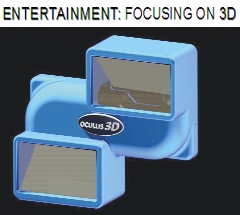Impatient with the sluggish pace of installing digital theater equipment capable of showing 3D films, a trio of business partners decided to develop and market a device that can be attached to existing film projectors. In starting Oculus3D, the three find themselves going up against one of the giants of the entertainment industry, Technicolor, which introduced in October its own 3D on film process projected by a proprietary lens. The Oculus team, however, insists that their OculR device is better than that offered by its rival. “It’s as easy as switching a lens from flat to scope,” said Al Mayer Jr., executive vice president and chief technology officer at Oculus3D. With all the major Hollywood studios releasing 3D films this year and more scheduled for 2010, the question of whether audiences will pay a premium for the films has been answered and now turns to how to get these films before more viewers. With a limited number of digital screens available no 3D film can have a wide release, nor can many such films be out at the same time. This summer demonstrated the quick revolving door 3D films face as Disney Pixar’s “Up” gave way to “Ice Age 3: Dawn of the Dinosaurs” that then gave way to “G-Force.” What that means is that money gets left on the table when the 3D films are pulled before their draw has diminished. The Walt Disney Co. released the latest version of holiday classic “A Christmas Carol” in November to more than 2,000 theaters with an additional 1,500 screens showing the 3D version. “I believe the audience would like to see (the 3D version) on all 3,000-plus screens,” said Ahmad Ouri, chief marketing officer for Technicolor, which has facilities in Burbank. “We are trying to help solve the problem.” Technicolor has seven major studios lined up to release 3D films using its process and will soon take delivery on 1,200 of the special lenses that will attach to standard 35mm projectors to show the films. Talks are taking place to line up movie theaters to use the lenses on a licensing basis. If Mayer and business partners Marty Shindler and Lenny Lipton find themselves in the position of David to Technicolor’s Goliath, it’s a position that is not daunting. The one word industry professionals keep repeating to describe what Oculus offers is smart, Shindler said. The company has partnered with a theater chain in the San Fernando Valley to install a silver screen to use for its tests. In coming months, industry groups and organizations will see demonstrations of the OculR system. The backgrounds of the three founders hint at the success Oculus may find. Mayer brings a manufacturing and development expertise honed during 26 years working at Panavision; Lipton holds 35 patents and served as the chief technology officer at RealD, a digital 3D technology provider; and Shindler worked at MGM, 20th Century Fox and LucasFilm before operating for 14 years an entertainment industry consulting firm. Both Oculus and Technicolor recognize that a scarcity of theaters able to show 3D films is a problem. Both have research showing that audiences care little whether a 3D film is celluloid or a digital file. Neither wants to wait for theaters to invest in digital cinema equipment and instead offer low-cost alternatives. How to provide those alternatives are where the companies differ. Oculus will use an algorithm to place the images side by side on film and the OculR device makes a single image onto a silver screen. Technicolor, on the other hand, uses the over/under format in which the film frame is split horizontally with two images. Oculus’s Mayer said the problem with the over/under format centers on potential framing and splicing errors that can cause the 3D to not appear properly. Technicolor, Ouri countered, has developed ways to prevent those issues from occurring in the projection booth. By offering its lens, Technicolor is not trying to compete against digital projection, a field it has been involved with for 10 years. The company rather sees its process as a potential replacement for traditional 2D films, Ouri said. The Oculus team sees themselves as placing a stake in a market where if they are successful will result in the entire film production chain profiting. “If we can get more theaters involved in 3D that will give producers more incentive to make more 3D movies because they will get more return on their investment,” Shindler said.
